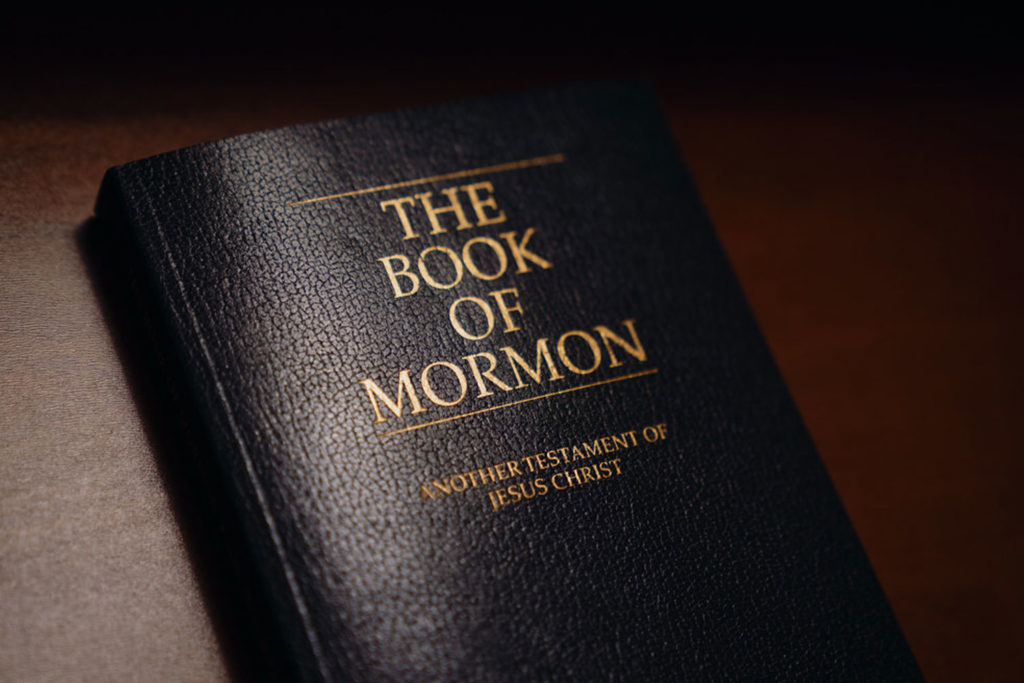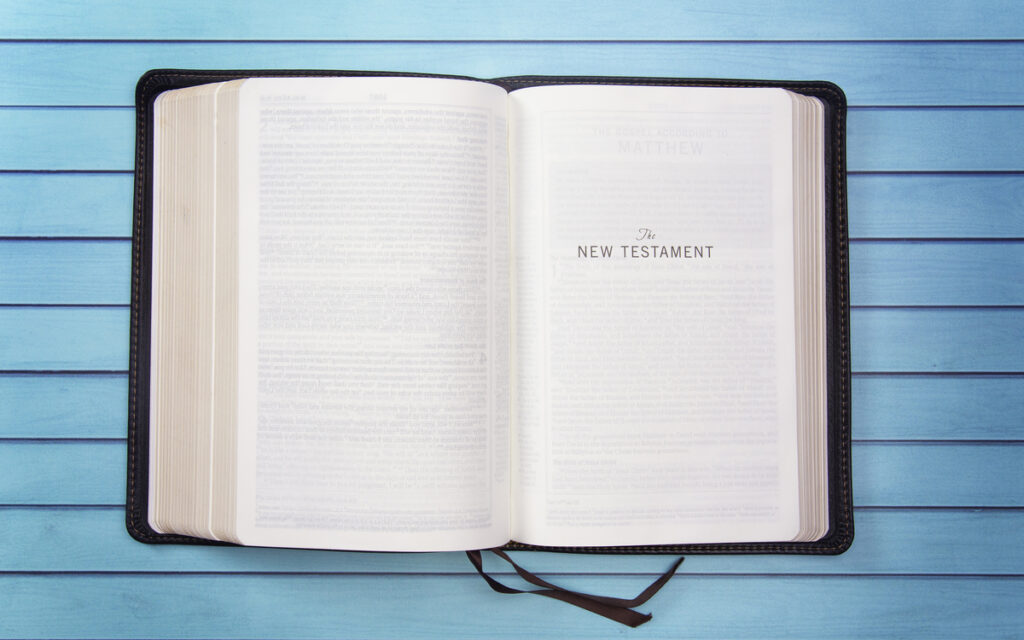By Tal Davis
Is It “Another Testament of Jesus Christ?”
The setting is a college library. An attractive young woman speaks to the television audience: “The Book of Mormon is a gift from The Church of Jesus Christ of Latter-day Saints when you call this toll-free number. Its teachings have given me a real peace that comes from understanding the Savior and what my Father in heaven’s plan is for me today and after this life. So please call, because I know it can give you that same peace.”
The spokeswoman represents one of the fastest growing religious movements in America today: The Church of Jesus Christ of Latter-day Saints (LDS), also known as the Mormons. This controversial religious movement in recent years has intensified its public relations activities nationwide via television, radio, and magazine advertisements. Central to the LDS public relations campaign is distribution of its well-known, yet little understood publication: The Book of Mormon- Another Testament of Jesus Christ (hereafter referred to by its traditional title, The Book of Mormon).
Who Are the Mormons?
Since its beginnings in 1830, The Church of Jesus Christ of Latter-day Saints has grown world-wide from six original members to nearly 13 million in 2006 (5.8 million in the U.S and Canada).
An even more startling statistic is that the LDS has more than 53,000 missionaries under appointment in 161 countries.1 Most of these are young men and women taking time out of college to serve two-year terms wherever the church sends them.
Worldwide, the LDS has more than 27,000 local congregations and 124 temples.2 LDS temples are special buildings designed for Mormons to conduct secret ceremonies necessary to prepare them for eternal life. These rituals include Celestial Marriage, Baptism for the Dead, and the endowment ceremonies. Only those Mormons holding an approved “recommend” from their bishop may enter the temples.
The LDS has attracted the concern of Baptists and other evangelical groups in recent years. One reason is the LDS’ aggressive missionary program among members of Christian churches. In recent years, the LDS has portrayed itself as a Christian denomination with a few distinctive emphases. Christian theologians, however, know that Mormonism is essentially different in its basic theological structure from that of historic Christianity. Mormons believe, for example, that God, called Heavenly Father, is a physical man of flesh and bone who once lived on a world like our own. Through righteous living, obedience to his Heavenly Father, and Celestial Marriage, he progressed to become the god of our universe. Mormons maintain that humans are the literal, procreated spirit children of Heavenly Father and his wife. The goal of all good Mormons is also to progress to the Celestial Kingdom (the highest level of heavenly glory) and become gods of other worlds.
Mormons are undeniably polytheistic. Jesus Christ, according to LDS doctrine, is also one of Heavenly Father’s spirit children who has attained godhood. Heavenly Father, Jesus Christ, and the Holy Ghost are three of many gods of other worlds.
Mormonism and the Bible
The official LDS statement of faith is its 13 “Articles of Faith” written by founder Joseph Smith Jr. Article eight says, “We believe the Bible to be the Word of God as far as it is translated correctly.”3 That statement seems to affirm what Baptists and other Christians regard to be true about the Bible-that it is the inspired Word of God. However, we must not overlook a significant qualification placed on the Bible by Smith. Smith said the Bible is the Word of God only “as far as it is translated correctly.” Mormons claim the Bible is an inspired book; nonetheless, they teach that in its current, standard form, it is a flawed record of God’s Word.
Smith insisted that texts utilized in the translation of all Bible versions were corrupted by the “apostate church” a few centuries after the New Testament era. He asserted that many “plain and precious parts” of the original biblical texts were altered so that Mormonism was removed. Due to this supposed corruption, Smith contended that a total restoration of original Christianity was necessary. He claimed that God led him, in 1830, to restore the true church to the earth complete with its prophetic office and authoritative priesthoods.4
In 1831, Smith started work on a “corrected translation” of the Bible. Smith’s translation, called the Joseph Smith Translation or InspiredVersion actually was a revision of the King James Version and contains hundreds of additions and changes, including the deletion of one entire book!5
Christians should realize the fallacies of Smith’s view of the Bible. To begin with, there is no indication of an apostate church to which Mormons refer. Genuine Christianity never was eliminated from the earth. Second, the argument that the Hebrew and Greek texts were corrupted, several centuries after Christ, is invalid. The textual evidence for both the Old and New Testaments has been verified by scholars from numerous ancient sources. Some Old Testament texts, found recently, actually date to a couple centuries before Christ. Textual studies confirm the accuracy of the current standard Greek and Hebrew texts of the Bible.
The Book of Mormon
As we have seen, the LDS’ contention that the Bible is unreliable is unwarranted. But what of their other socalled “standard works?” The LDS’ eighth Article of Faith also says, “We believe The Book of Mormon to be the word of God.” The ninth article further states, “We believe all that God has revealed, all that He does now reveal, and we believe that He will yet reveal many great and important things pertaining to the Kingdom of God.”6
The above statements imply that the Bible is not the only or final revelation from God. Mormons assert that their other “standard works” are also divinely inspired and that additional revelation may come through their living prophet, the president of their church.
The best known of these additional scriptures is The Book of Mormon. Mormons believe that The Book of Mormon is actually a compilation of 15 ancient books originally written from 600 B.C. to A.D. 400. Mormons claim that Joseph Smith Jr., a New York farm boy, uncovered a set of golden plates, upon which were inscribed a record of the events and lives of people in pre-Columbian America. The inscriptions supposedly were written in a language called “reformed Egyptian,” which Smith was able to decipher miraculously and publish as The Book of Mormon.
The Book of Mormon purportedly is the history of ancient American people who were descendants of pre- Babylonian exilic Jews. Led by a prophet named Lehi, Jewish refugees sailed to America about 600 B.C. and established a civilization in the New World. The descendants of Lehi divided into two groups-the Nephites, a race of righteous white people, and the Lamanites, a race of warlike, evil, and dark-skinned people. The Lamanites, according to Mormon teaching, were the ancestors of the Native American population of today. The Nephites, Mormons say, were destroyed in a series of battles with the Lamanites. The last Nephite leader, a man named Mormon, supposedly collected the records of his people and inscribed them on golden plates. His son, Moroni, the last surviving Nephite, buried the plates in a hill in what later became Manchester County, New York. The plates were recovered by Smith, in 1827, when the resurrected Moroni, appearing as an angel, told him where to dig for them.7 Moroni later took the plates to heaven.
The most remarkable aspects of The Book of Mormon accounts were the reported religious practices of the ancient Americans. The Nephites, we are told, continued their Jewish traditions on this continent-building temples to God; having spiritual revivals; and, most significantly, establishing a Christian church. The Book of Mormon’s most spectacular recorded event was a postresurrection appearance of Jesus Christ Himself among the Nephite people (3 Nephi 11). Thus the LDS contends that The Book of Mormon is “another testament of Jesus Christ.”
Today, Mormons use The Book of Mormon in much the same way that Christians use and study the Bible. They maintain that their book contains the “fullness of the everlasting gospel” that was lost by the early apostate churches in the Old World. They say that Smith was a latter-day prophet of God who restored true Christianity to the earth.
How Mormons Use The Book of Mormon
Mormons maintain that Christians, and non-Christians alike, should leave their own faiths and churches and become members of the LDS. Mormon missionaries have, as their primary task, the proclamation of the “gospel” of the “restored church.” One method for introducing people to Mormonism is through the publication and distribution of The Book of Mormon. Mormons give interested nonmembers free copies in the hope they will read it and become convinced of its validity. Mormons point to a section of The Book of Mormon that promises, “And when ye shall receive these things, I would exhort you that ye would ask God, the Eternal Father, in the name of Christ, if these things are not true; and if ye shall ask with a sincere heart, with real intent, having faith in Christ, he will manifest the truth of it unto you, by the power of the Holy Ghost” (Moroni 10:4).8
Mormons believe a key element for converting people to Mormonism is to convince them to believe The Book of Mormon and to pray for a “testimony” of the true church. Mormons describe this experience as a subjective “burning in their bosom” confirming their church’s claims. Most LDS converts do not make an objective, scholarly investigation of Mormonism. Investigators who look closely at the origins, history, and contents of The Book of Mormon usually come to radically different conclusions about the truth of Mormonism.
Origin of The Book of Mormon
Mormons say that The Book of Mormon was written by divinely inspired ancient Americans and later was miraculously translated by Joseph Smith Jr. In order for Christians or others to accept these claims, Mormons must demonstrate that their version of The Book of Mormon’s origin and story is historically accurate. The burden of proof rests on two points. First, can the Mormons show sufficient evidence, apart from The Book of Mormon itself, to corroborate its historical record? Second, can the Mormons establish, beyond a reasonable doubt, that Smith’s account of the discovery and translation of The Book of Mormon is true? A closer look at the objective evidence does not confirm LDS assertions.
Archaeology and The Book of Mormon
Christians do not claim that the science of archaeology “proves” the Bible is a supernaturally inspired book. Nonetheless, archaeological research has provided evidence for the historical reliability of the Bible. Many discoveries have confirmed names, cities, geographic locations, dates, political leaders, and other incidental information mentioned by the biblical writers. Even some skeptics have been amazed by the accuracy of the biblical data.
The Bible, therefore, is supported in its truth claims by the corroborating evidence of geography and archaeology. That assertion cannot be said for The Book of Mormon. Several decades of archaeological research, funded by LDS institutions, concentrating in Central America and Mexico, have yielded nothing that corroborates the historical events described in The Book of Mormon.
- No Book of Mormon cities have been located.
- No Book of Mormon names have been found in New World inscriptions.
- No genuine inscriptions have been found in Hebrew.
- No genuine inscriptions have been found in Egyptian or anything similar to Egyptian, which could correspond to Joseph Smith’s “Reformed Egyptian.”
- No ancient copies of Book of Mormon scriptures have been found.
- No ancient inscriptions of any kind indicate that the ancient inhabitants held Hebrew or Christian beliefs-all are pagan.
- No mention of Book of Mormon people, nations, or places has been found.
- No artifact of any kind that demonstrates The Book of Mormon is true has been found.9
The Smithsonian Institution’s National Museum of Natural History for a number of years distributed a written statement denying The Book of Mormon is a valid guide for archaeological exploration.10 All evidence contradicts The Book of Mormon‘s accounts about the origin of American Indians; the earliest explorations of the New World; plant and animal life in the Americas; use of metal, steel, and silk by ancient Americans; and other supposed similarities between pre-Columbian Indian cultures and those of the Old World.
What does this mean practically? Suppose there was no external evidence for any of the events described in the Bible? What if no one knew where the countries of ancient Israel, Judah, Egypt, or Babylon were located? What if there was no other evidence that the cities of Jerusalem, Bethlehem, Athens, or even Rome ever existed? The absence of any corroborative evidence from external sources would cast a dark shadow of doubt on the Bible itself, would it not?
The Life of Joseph Smith Jr.
Members of The Church of Jesus Christ of Latter-day Saints always have regarded Joseph Smith Jr. as one of the greatest religious leaders of all history. They regard him as an inspired prophet. However, on examination of the historical evidence about the life of Smith, one is led to a different sort of person than is usually presented in official LDS literature. In recent decades, vast amounts of documentation concerning the events of Smith’s life and the early Mormon movement have come to light. Documented evidence conclusively ties Smith to occult practices, bank fraud, polygamy, and other biblically condemned acts.
Also, scholars have demonstrated Smith’s possible utilization of other works upon which he may have based The Book of Mormon story. For example, Smith likely had access to several books written in the early 1800s containing fictional scenarios similar to that in The Book of Mormon.
Other theories have been put forth as to how Smith wrote The Book of Mormon. Probably the best explanation is that he borrowed the ideas of several previous authors, combined them with story lines and passages taken from the King James Version of the Bible, and then wrote The Book of Mormon himself. Mormons sometimes argue that Smith was uneducated and did not have the capability of writing a book as complex as The Book of Mormon. The facts show, however, that Smith was literate and had access to several libraries near his home.
Fawn Brodie, Smith’s biographer, believed that he was an intelligent and charismatic young man. She argued that he was more than capable of concocting the imaginative tales contained in The Book of Mormon. Whatever the origin of Smith’s ideas, the evidence indicates that he had access to numerous resources and possessed the ability to draw them together in writing.
Changes in The Book of Mormon
The Church of Jesus Christ of Latter-day Saints claims that Smith translated The Book of Mormon miraculously, using tools provided by the angel Moroni. They maintain that he recorded the words given him by God and thus ultimately was not responsible for the production of The Book of Mormon in its final English form. It was entirely a divine process.
If that is true, then the LDS will have difficulty explaining why there have been numerous revisions and changes in The Book of Mormon in the 180 years since the translation and original edition. Former Mormons, Jerald and Sandra Tanner, have documented nearly 4,000 changes in The Book of Mormon from its original edition. Though most changes were corrections of errors in grammar and spelling, some had significant historical, theological, and doctrinal implications. If The Book of Mormon was miraculously translated as Smith claimed, why the need for so many revisions? The Tanners’ observation probably answers the question:
“When a person examines the unchanged text of the 1830 (original) edition of The Book of Mormon it becomes very obvious that it was written by someone without a great deal of education. The style and the type of mistakes that are found in the first edition of The Book of Mormon are similar to those found in (another) document written by Joseph Smith in the early 1830’s.” 11
Christians affirm the inspiration and authority of the Bible. However, the original texts of the biblical books were not written in English. Biblical authors wrote in Hebrew, Koine Greek, and, in a few instances, Aramaic. Thus, we do not confer the same level of inspiration for any translation as we do for the original autographs in their original languages. Translators are obliged to review carefully the biblical texts in their original languages when doing their work. Translation is a difficult task, and there is rarely universal satisfaction with the final outcome. Revisions and corrections of translations are expected. Only the original Greek and Hebrew texts are invariable.
The LDS, however, maintains that Smith’s English version of The Book of Mormon was not subject to human fallibility. Nonetheless, Mormon scholars have had to acknowledge errors and inconsistencies in Smith’s original work. In some cases, the changes obviously were made to cover up embarrassing aspects of The Book of Mormon text. An example is 2 Nephi 30:6, a verse promising that in the “latter-days” many Lamanites (American Indians) would convert to Mormonism and receive many blessings. Recent versions of The Book of Mormon state the verse’s last phrase to read, “And many generations shall not pass away among them (the Lamanites), save they shall be a pure and delightsome people (emphasis mine).”12 All editions published before 1980 stated the verse this way . . . “And many generations shall not pass away among them, save they shall be a white and delightsome people.”13 The revision clearly reflects a change in the traditional LDS view that Native Americans were cursed with dark skin because of their disobedience to God. We ask, by what authority do Mormons make such a change? They answer that their leaders are inspired men, thus they can change anything they deem necessary.
Is The Book of Mormon “Mormon”?
Obviously, The Book of Mormon does not teach orthodox Christianity; but what is more interesting is that it does not teach modern Mormonism either. Most LDS doctrines do not originate with The Book of Mormon. LDS teachings concerning the godhead, eternal progression, exaltation to godhood, Celestial Marriage, Baptism for the Dead, a “Mother God,” polygamy, and a plurality of gods are not found in The Book of Mormon. In fact, The Book of Mormon in many cases contradicts those standard LDS doctrines.
LDS doctrinal beliefs are derived essentially from its other two “standard works”: The Doctrine and Covenants (D&C) and The Pearl of Great Price (PGP). The D&C contains numerous revelations, supposedly given to Joseph Smith Jr. over a number of years, detailing many doctrinal and practical precepts. The PGP is an additional collection of supposedly inspired texts collected and translated by Smith. One section, entitled “The Book of Abraham,” has been discredited by Egyptologists examining the Egyptian papyri from which Smith derived his “inspired” translation.
Conclusions
The Bible has withstood the attacks of skeptics for centuries. Christians remain confident that it is the reliable, inspired Word of God. Historical research, archaeology, and textual studies have confirmed its veracity. The Book of Mormon, conversely, lacks even meager support for its historical or theological contents. Christians respect Mormons’ lifestyles and affirm their rights to believe and propagate their faith. However, The Book of Mormon is not “another testament of Jesus Christ” nor is Mormonism an authentically Christian movement.
Notes
1. ldschurch.org/conference
2. Ibid.
3. Joseph Smith Jr., The Pearl of Great Price (Salt Lake City: The Church of Jesus Christ of Latterday Saints, 1986), pp. 60-61.
4. Gospel Principles (Salt Lake City: The Church of Jesus Christ of Latter-day Saints, 1986), pp. 60-61.
5. Joseph Smith Jr., The Holy Scriptures—Inspired Version (Independence, Mo.: Herald Publishing House [Reorganized Church of Jesus Christ of Latter Day Saints], 1974). Smith removed the Song of Solomon from his version.
6. Joseph Smith Jr., The Pearl of Great Price, pp. 60- 61.
7. Ibid., pp. 52-55.
8. Joseph Smith Jr., The Book of Mormon-Another Testament of Jesus Christ (Salt Lake City: The Church of Jesus Christ of Latter-day Saints, 1982), p. 529.
9. Hal Hougey, Archeology and The Book of Mormon (Concord, Calif.: Pacific Publishing Co., 1983), p. 12.
10. “Statement Regarding The Book of Mormon,” Prepared by the Department of Anthropology, Smithsonian Institution, 1988. (Available from Public Information Officer, Department of Anthropology, National Museum of Natural History. Smithsonian Institution, Washington, DC 20560).
11. Jerald and Sandra Tanner, The Changing World of Mormonism (Chicago: Moody Press, 1981), pp. 128-133.
12. Joseph Smith Jr., The Book of Mormon (1982 ed.), p. 112.
13. Joseph Smith Jr., The Book of Mormon (Salt Lake City: The Church of Jesus Christ of Latter-day Saints, 1974), p. 102.
Adapted from Discipleship Training magazine, February 1992.
© 1992 The Sunday School Board of the Southern Baptist Convention, Nashville, Tennessee All rights reserved. Used by permission.
Published March 30, 2016




